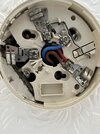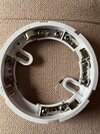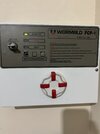Thats clearly a base from a zoned fire alarm system, not a domestic smoke detector, and it seems its been connected with break on the neg rather than pos. What fire panel is this on? (picture please) and what detector head have you removed and what are you replacing it with?
I'm assuming this is now all your property and its not just one area you occupy in the larger building, because if thats the case, then you shouldn't be touching it, but assuming its just propecting only your house and its just there becuase of the previous use then....
Disconnect it, check for voltage on each of the incomming legs, lukily one is red/black the other is brown/blue, one of them will give you 24v. Thats the In, the other is the out. Brown and red go to the L1 terminals in accordance with in and out, the blue and black to L2. The Shotkky diode is meant to be left in place. Do you know how to correctly test it when you are done, including checking for correct indication of fault if the head is removed?






